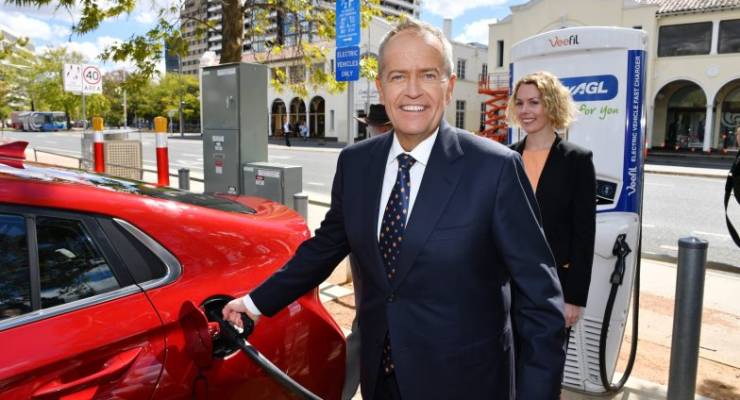
In this year’s great pre-election flourish of promises, electric vehicles have been the first to bloom. The Coalition’s response to Labor’s target of having 50% of car sales be electric vehicles by 2030 has been fierce. One might expect Scott Morrison to go hard at any Labor policy adjacent to climate change but even “moderate” liberals have attacked the plan as “Soviet” and various marginal MPs have jumped aboard.
Undeterred, Labor plans to inject tens of millions into the production of electric vehicle production and thus revive Australia’s moribund manufacturing industry.
As Crikey noted earlier this week, the Coalition’s hysteria seems a little confused given they’ve also had months of enthusiastic spruiking of electric vehicles. For their benefit, and yours, Crikey is here to break down the facts and figures on electric cars.
What are each sides’s targets?
Part of Labor’s climate plan is to aim for 50% of car sales to be electric vehicles by 2030 and 50% of the government’s fleet to be electric by 2025.
The Coalition do not yet have a specific policy, but what we know about it is remarkably similar to what Labor has said. Senate estimates this week revealed the environment department modelling for Morrison’s climate policy assumes electric vehicles will make up between 25% and 50% of new car sales by 2030.
Kristin Tilley, first assistant secretary of the department’s climate change division, told the hearings that projected emissions cuts of 10m tonnes through the Coalition’s proposed electric vehicles strategy were based on data indicating electric cars could account for 25-50% of new sales by 2030 “if supported by coordination and facilitation of local state and commonwealth actions coordinated through a national strategy”.
What’s the go with car charging?
Bill Shorten copped a lot of flack for his claim on the Kyle and Jackie O Show that electric cars can be charged in 8 to 10 minutes; The Australian‘s associate editor Chris Kenny countered “more like 8 to 10 hours to recharge your EV at home or, if you have access to a special fast charger, about an hour”.
Well, we can look to the Coalition for some figures here.
Treasurer Josh Frydenberg claimed last year they could be charged in less than 30 minutes. While in the aftermath of the Shorten announcement Energy Minister and invisible man Angus Taylor posted a storm of anti-electric car tweets — including attacks based on discredited Top Gear segments — last year he promised electric vehicles “will soon have access to an ultra-rapid charging network” that “will provide a range of up to 400 kilometres in just fifteen minutes”.
The reason the answer has veered so widely is that it depends on many factors. How big is the car, how flat is the battery, how far do you need to go before you can charge again, and where are you getting your power from?
Electric vehicle charging website, Pod Point, provides a simplified table, showing the charging period from full to empty be anywhere 30 minutes or more than 12 hours, while caradvice.com.au provides a very detailed rundown of cars and chargers, which details how 2.4 Kw charger will take 43 hours to fully charge your Jaguar I-Pace, while 100 Kw DC power source will get the job done in 45 minutes.
A plain speaking article on Whichcar puts it thus:
Plug an EV car into the 240-volt socket in your garage and it will take at least overnight to provide a full charge from empty.
But it’s a different story with DC fast chargers and high-capacity batteries, which currently sees vehicles such as the Kia e-Niro, Jaguar I-Pace, the new Nissan Leaf, Mercedes-Benz EQC and Hyundai Kona Electric receive an 80% charge in about 40-50 minutes. All of these cars will be available here by the end of the year — and some are already on our roads.
Will they really ban utes?
Taylor said Labor’s policies would lead to popular vehicles such as the Toyota Hilux being banned, because of the proposed vehicle emission standard. Senator Michaelia Cash decided to go even harder, tweeting:
Labor need to explain to Australia’s tradies why they want to ban their favourite utes and force them to pay more #saveourtradiesutes
Morrison did that Morrison dad thing, complaining Labor would take away the cars that Aussies love, those with “grunt”. The NRMA, Australia’s largest motoring body, rejected the claim that Labor’s policy would affect consumer choice, saying the target — which, again, isn’t that different to the Coalition’s — applies only to half the vehicles sold, would not be met for 11 years, and that manufacturers are developing or already sell electric versions of large vehicles. Inconveniently for the Coalition, Toyota don’t seem to agree either.








Crikey is committed to hosting lively discussions. Help us keep the conversation useful, interesting and welcoming. We aim to publish comments quickly in the interest of promoting robust conversation, but we’re a small team and we deploy filters to protect against legal risk. Occasionally your comment may be held up while we review, but we’re working as fast as we can to keep the conversation rolling.
The Crikey comment section is members-only content. Please subscribe to leave a comment.
The Crikey comment section is members-only content. Please login to leave a comment.